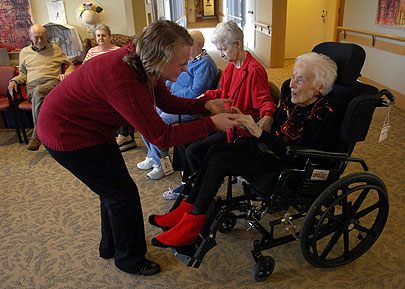|
Training Helps Workers Understand
By Elvira Cordileone, Toronto Star
Canada
January 10, 2008

Assistant Jennifer Shaw spends time with Bernadette Copeland, 81, at the Providence LTC facility in mid-Toronto.
Nursing home worker Maciel Arias often had to deal with a difficult dementia patient, but trying to explain things to the woman proved fruitless.
Then, Arias took a daylong course called U-First, which taught her a more effective way. The next time the patient came to the nursing station pleading for a TTC token so she could go home, Arias gave her one.
"You should have seen the glow on her face," says Arias, who works at the St. Clair-O'Connor Community home at 2701 St. Clair Ave. E. "Even though it was her ticket home, she went back to her room, which was, in fact, her home."
Ontario has more than 600 long-term-care homes, all regulated by the province, that are designed for people needing 24-hour nursing or personal care.
People with dementia comprise up to 70 per cent of those residents, making specialized training for their caregivers crucial, says Ken Le Clair, a geriatric psychiatrist who is co-chair of the Canadian Coalition for Seniors Mental Health and chair of geriatric psychiatry at Queen's University.
"They perceive and understand the world differently," he explains.
In fact, Le Clair says long-term-care workers need a broad knowledge base because many of their charges have a variety of chronic diseases, in addition to dementia or Alzheimer's, and take many medications.
Arias, a mother of three who is studying for a nursing degree part-time, is one of 57,000 personal support workers employed in Ontario's long-term-care facilities. Not only do most of those workers have no specialized training in dementia, but only 20 per cent have any formal training in health care, according to Catherine Brookman, director of special projects for the Ontario Community Support Association. This group provides the U-First course and another called Pieces, geared to professional staff, such as nurses.
Brookman says most long-term-care workers have only general training provided by their employers, resulting in "uneven skills."
Those skill requirements could improve under a new provincial law passed last June for long-term care facilities. It will take effect once the province drafts accompanying regulations. That process will include a review of staffing and care standards in long-term care.
Proper staffing levels and training are essential for good long-term care, says Lois Dent, president of Concerned Friends of Ontarians in Care.
"Some homes have no personal support workers especially trained for dementia and some have insufficient staff to work with people with dementia," Dent says.
She notes many workers have 12 to 14 residents to look after, so they're always rushing. But hurrying a dementia patient can trigger disruptive behaviour.
Dent also points out that desirable homes have long waiting lists.
For example, Cardinal Ambrozic Houses of Providence at St. Clair and Warden Aves. is a long-term-care facility with 288 beds and a waiting list almost as long, says administrator Jo Harris.
Mary Lou Copeland placed her mother, Muriel Norbert, 97, at Providence five years ago, and her mother-in-law, Bernadette Copeland, 81, found a bed there in November. Both women have dementia and both waited many months for a spot to open up.
"Providence was our first choice for both," Copeland says. "We also chose it because it's Catholic and (my mother) can go to mass every day."
Harris says every staff member, including housekeepers, receives dementia-care training and those working in the secure units get additional education.
"A lot of the training is on how to approach and de-escalate a situation," Harris explains.
Resident program manager Myrna Loyst offers an example.
One unit had many dementia patients who would stand by the door waiting for someone to come in so they could get out.
Loyst says they hired an artist to paint a large mural to camouflage the exit. Unable to find the door, the residents soon forgot about wanting to leave.
More Information on World Health Issues
Copyright © Global Action on Aging
Terms of Use |
Privacy Policy | Contact
Us
|



